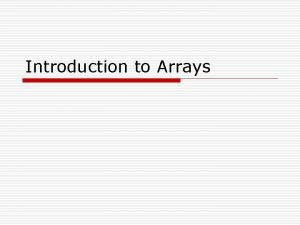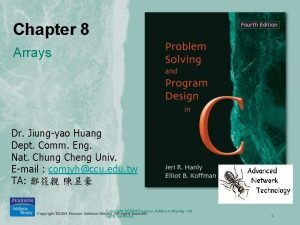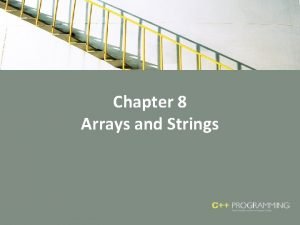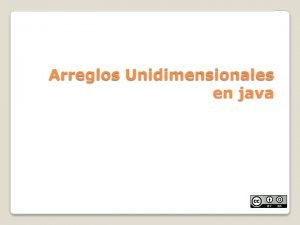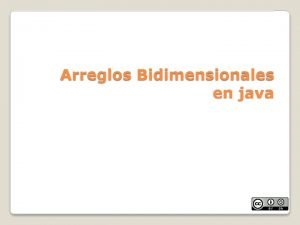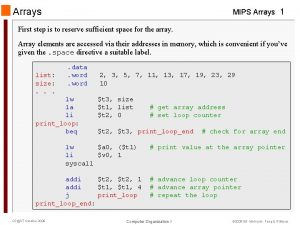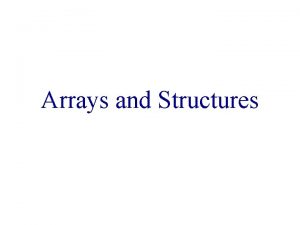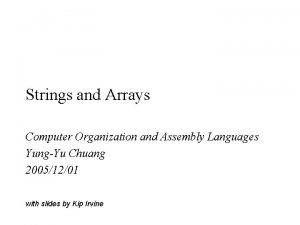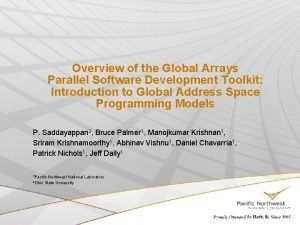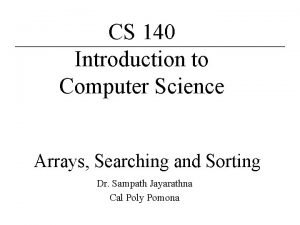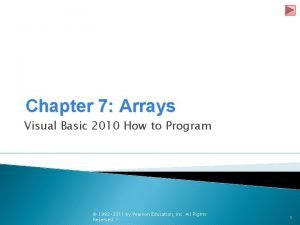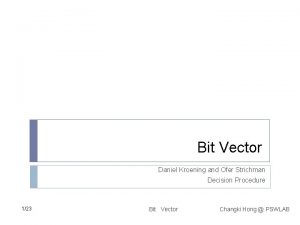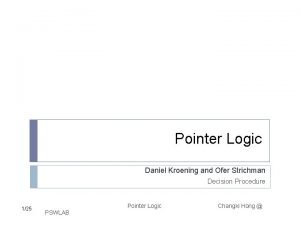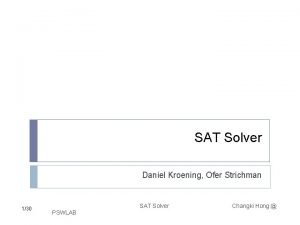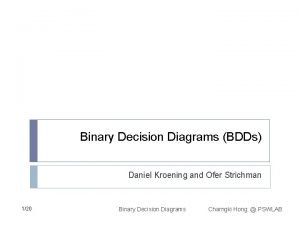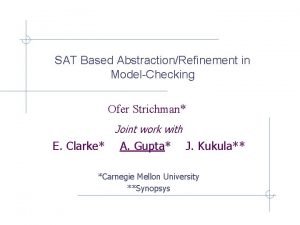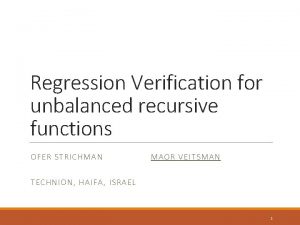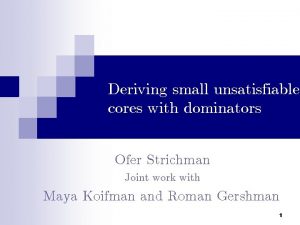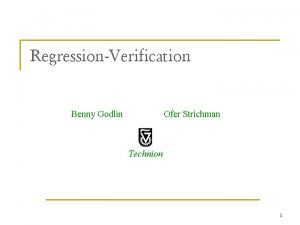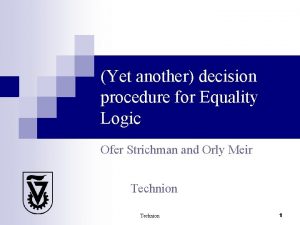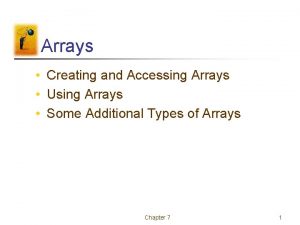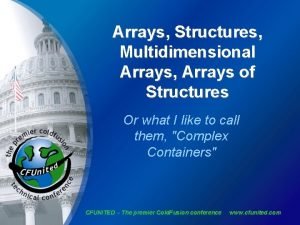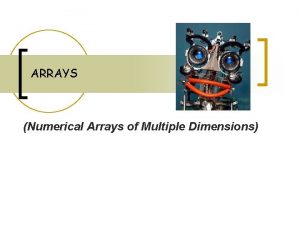Arrays Daniel Kroening and Ofer Strichman Decision Procedure




















- Slides: 20

Arrays Daniel Kroening and Ofer Strichman Decision Procedure 1/20 Arrays Changki Hong @ PSWLAB

Array logic � Arrays are a basic data structure that is used in most software programs � modeling � Array memories and caches in hardware design. logic permits expressions over arrays. � Arrays can be formalized as maps from an index type to an element type. � Array logic has two basic operations � Reading � Writing 2/20 Arrays Changki Hong @ PSWLAB

Contents � Introduction � Arrays as uninterpreted function � A reduction algorithm for array logic � Conclusion 3/20 Arrays Changki Hong @ PSWLAB

Array logic � Array is the set of functions that map an index value to an element. � Index type TI � Element type TE � Array type � Let denote an array. � Two 1. 2. 4/20 basic operations on arrays: Reading : reads an element with index from a. The value of the element of index i is denoted by a[i]. Writing : writes an element with. Let denote the value to be written. The array a where element i has been replaced by e is denoted by a{i e}. Arrays Changki Hong @ PSWLAB

Index logic � The index logic should permit existential and universal quantification. � Existential “There exists an array element that is zero” � Universal � Array quantification “All elements of the array are greater than zero” logic is defined by index logic and element logic � Validity for array logic is undecidable, since index logic permits existential and universal quantification. � First-order-logic 5/20 is undecidable. Arrays Changki Hong @ PSWLAB

The syntax of array logic denotes an atom in the index logic � atom. E denotes an atom in the element logic � atom. I 6/20 Arrays Changki Hong @ PSWLAB

Read-over-write axiom � Mc. Carthy proposed. � After the value e has been written into array a at index i, the value of this array at index i is e. The value at any index j ≠ i matches that in the array before the write operation at index j: 7/20 Arrays Changki Hong @ PSWLAB

Example � The main step of correctness argument is to show that the invariant in the line 7 is maintained by the assignment in line 6. � A common way to do so is to generate verification conditions. 8/20 Arrays Changki Hong @ PSWLAB

Example (cond. ) � We can obtain the following verification condition for the claim: � Proving validity of this formula shows that the loop invariant is maintained. � Prove by means of read-over-write axiom 9/20 Arrays Changki Hong @ PSWLAB

Arrays as uninterpreted functions � Here we consider a method to check satisfiability of array logic formula whose quantifications are removed by a reduction mechanism. � We will see the reduction scheme. � array logic formula with quantification array logic formula without quantification � Here � array logic formula without quantification equality formula with uninterpreted functions � How to reduce? array type uninterpreted function � index type function argument � 10/20 Arrays Changki Hong @ PSWLAB

Example � Array logic without quantification � Equality � Apply 11/20 formula with an uninterpreted function Bryant’s reduction Arrays Changki Hong @ PSWLAB

A reduction algorithm for array logic � We define here a restricted class of array logic formulas in order to obtain decidability. Recall arbitrary formula of original array logic is undecidable. � From hereon we will learn how to reduce given an array logic formula to the decidable array logic formula. � � We consider formulas that are Boolean combinations of array property. � The reduced decidable array logic formula has array property. 12/20 Arrays Changki Hong @ PSWLAB

Array property � Def. An array logic formula is called an array property if and only if it is of the form � and satisfies the following conditions: The predicate 1. , called the index guard, must follow the grammar. The “integer-identifier” used in “term” must not be 2. 13/20 The predicate . is called the value constraint. Arrays Changki Hong @ PSWLAB

Extensionality rule � Def. Extensionality rule is the elementwise equality of two arrays. � Extensionality � index � 14/20 is an array property: guard is simply TRUE in this case. is the value constraint of Extensionality rule. Arrays Changki Hong @ PSWLAB

Example � Array logic formula � Array property formula � Only second conjunct is not array property formula � Write-rule : Array updates can be handled by replacing each expression of the form by a fresh variable a’ of array type, and by adding two constraints that correspond directly to the two cases of the read-over-write axiom: 1. 2. 15/20 for the value that is written, for the values that are unchanged. Arrays Changki Hong @ PSWLAB

A reduction algorithm � Array-Reduction � Input : An array property formula � Output : A formula with uninterpreted functions 1. 2. 3. 4. 5. Apply the write rule to remove all array updates from Replace all existential quantifications of the form P(j), where j is a fresh variable. Replace all universal quantifications of the form . by by Replace the array read operations by uninterpreted functions and obtain. return. 16/20 Arrays Changki Hong @ PSWLAB

A reduction algorithm � In � step 3 The universal quantifiers replaced by the conjunction , where the set denotes the index variables that i might possibly be equal to in the formula. set contains the following element : � 1. 2. 3. 17/20 All variables used as an array index in that are not quantified variables. All variables used inside index guards in that are not quantified variables. If contains none of the above, is {0} in order to obtain a nonempty set of index variables. Arrays Changki Hong @ PSWLAB

Example � We want to check satisfiability of = 1. Apply the write rule to remove all array updates from . = 2. Replace all existential quantifications of the form where z is a fresh variable. by P(z), = 18/20 Arrays Changki Hong @ PSWLAB

Example (cond. ) 3. Replace all universal quantifications of the form by , where = { i, z } 4. Remove trivially satisfied conjuncts. 5. Replace the two arrays a and a’ by uninterpreted functions Fa and Fa’. 19/20 Arrays Changki Hong @ PSWLAB

Conclusion � Validity of an array logic formula without any reduction is undecidable. � Reduction algorithm needed. � Reduction algorithm outputs a formula uninterpreted functions 20/20 Arrays with Changki Hong @ PSWLAB
 Ofer aharony
Ofer aharony Objectives of decision making
Objectives of decision making Dividend decision in financial management
Dividend decision in financial management Dynamic arrays and amortized analysis
Dynamic arrays and amortized analysis Searching and sorting arrays in c++
Searching and sorting arrays in c++ Advantages and disadvantages of arrays in data structure
Advantages and disadvantages of arrays in data structure Decision tree and decision table examples
Decision tree and decision table examples Parallel arrays java
Parallel arrays java Array of arrays c++
Array of arrays c++ Ragged array
Ragged array Veteork
Veteork C++ parallel arrays
C++ parallel arrays Why do we need arrays?
Why do we need arrays? Arreglo unidimensional en java
Arreglo unidimensional en java Java arreglos bidimensionales
Java arreglos bidimensionales Arrays mips
Arrays mips Polynomial representation using array in c
Polynomial representation using array in c Arrays in arm assembly
Arrays in arm assembly Global arrays in c
Global arrays in c Computer science arrays
Computer science arrays Arrays visual basic
Arrays visual basic









